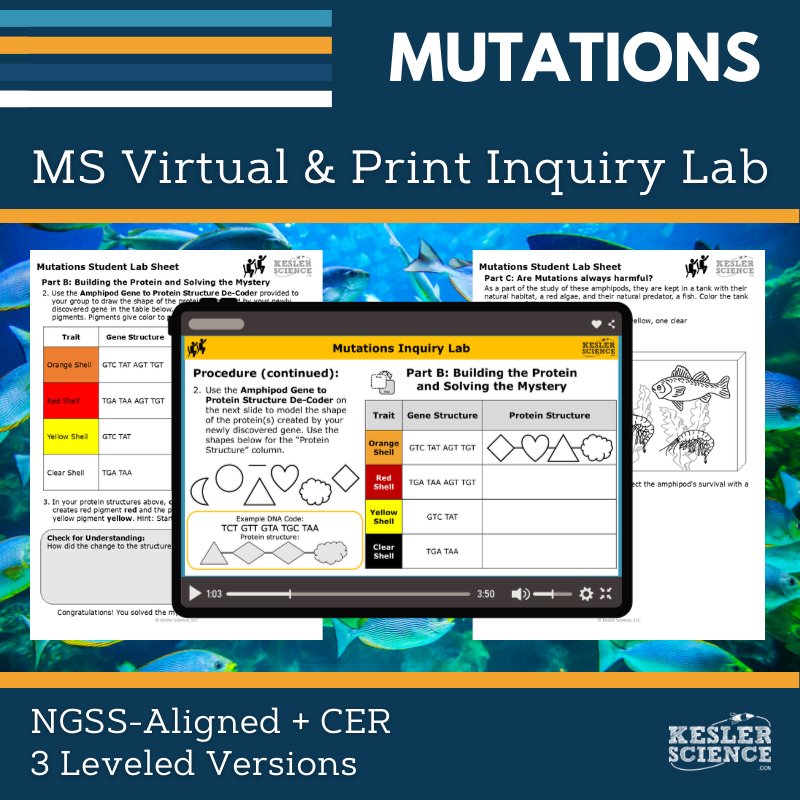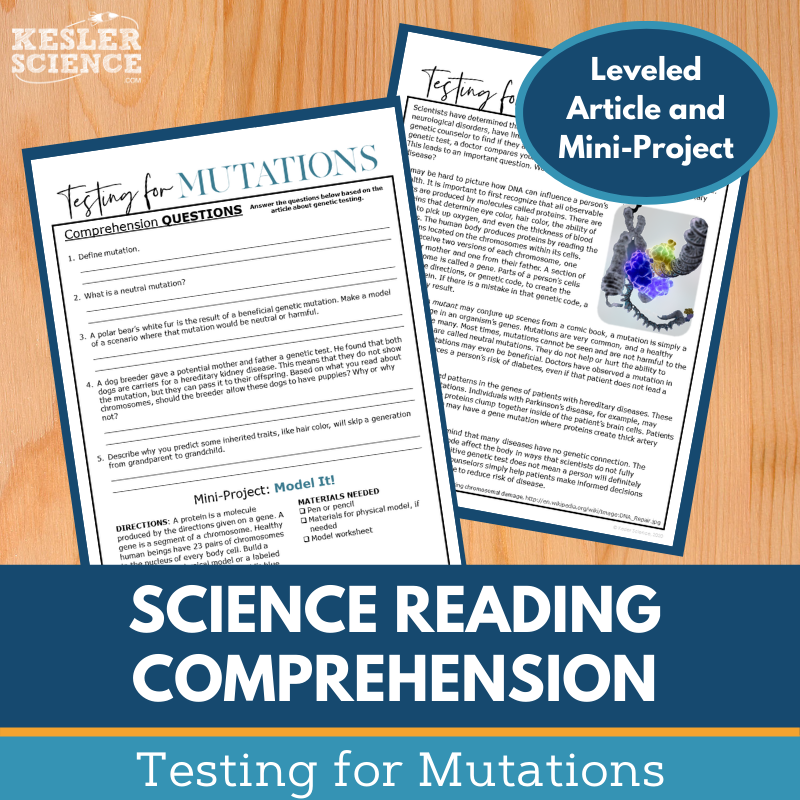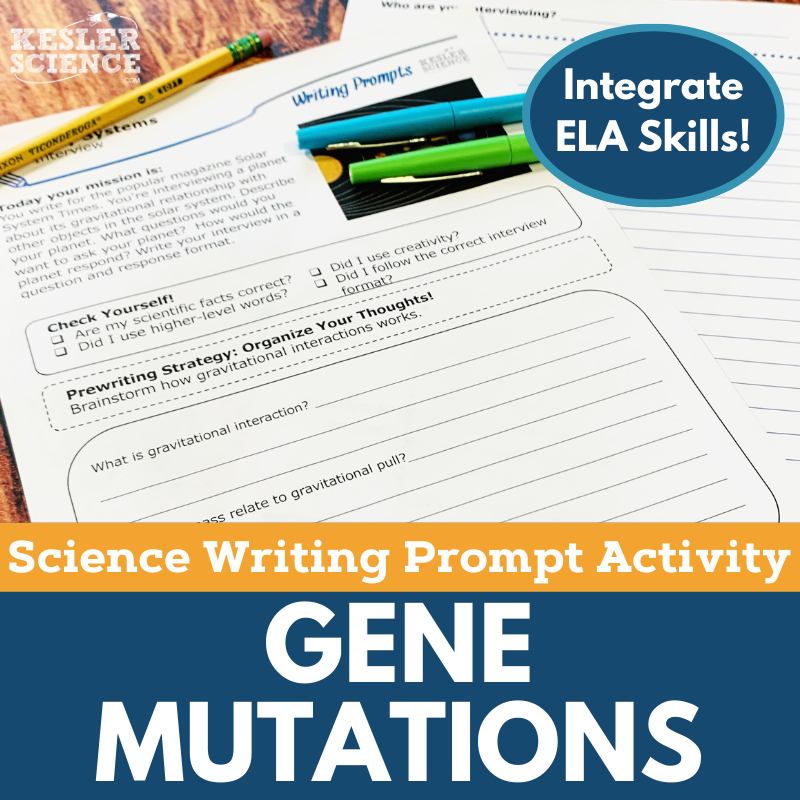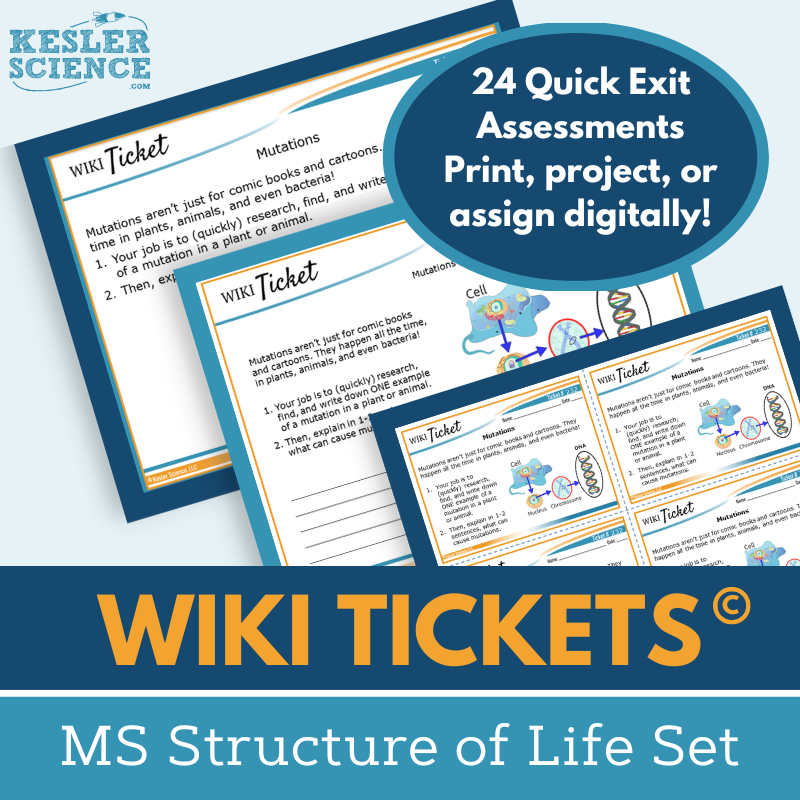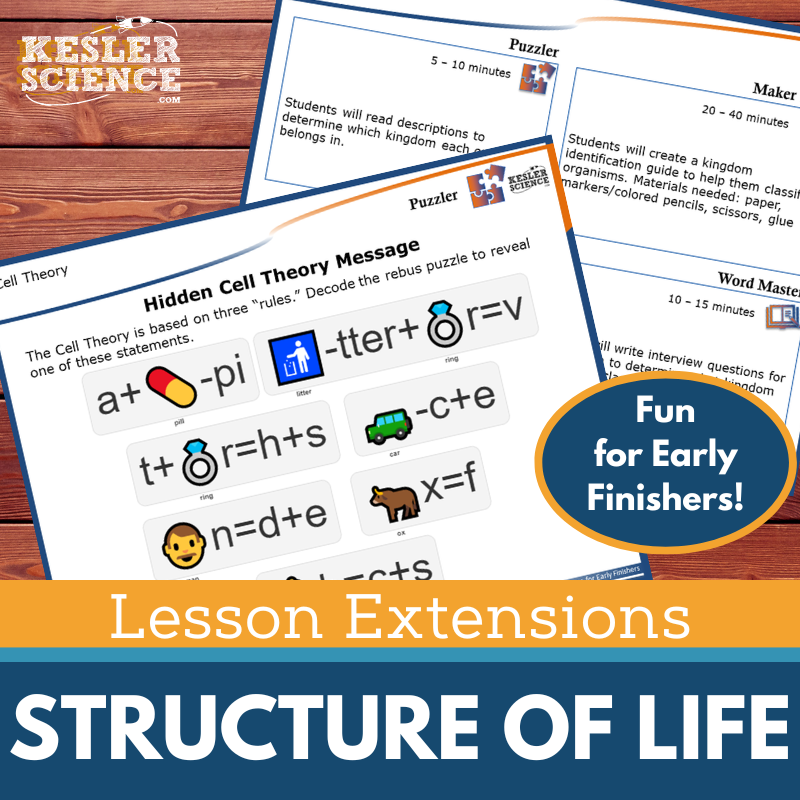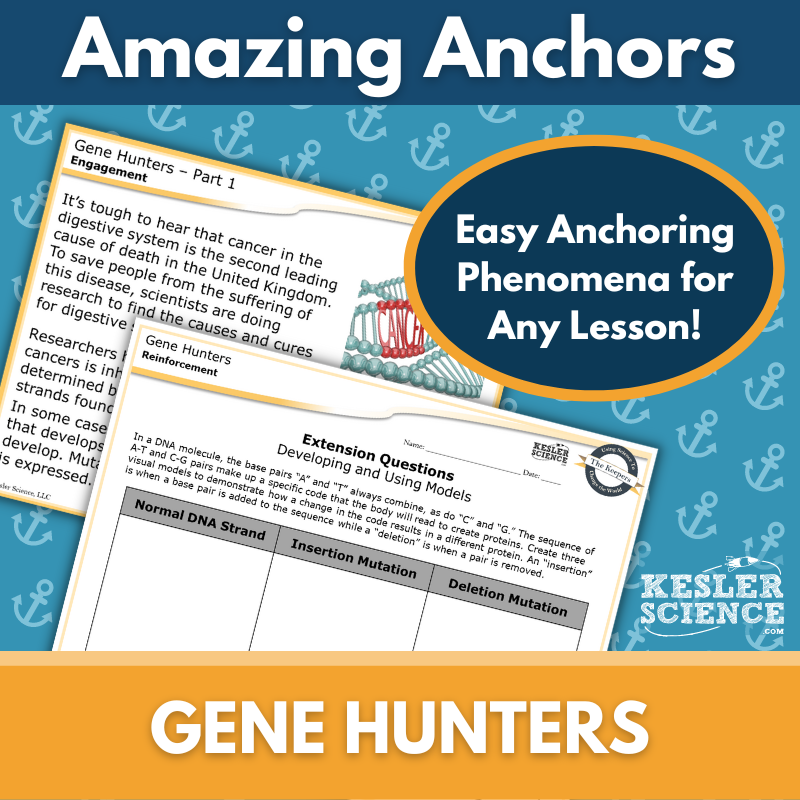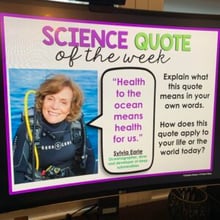Mutations Activities for Middle School Science
Aligned with NGSS MS-LS3-1, these engaging lessons explore gene mutations, their impact on proteins, and how they influence an organism’s traits. The resources below will give students a comprehensive understanding of mutations. All of the following materials are also included in the Kesler Science Membership.
The Mutations Inquiry Lab aligns with NGSS MS-LS3-1, guiding students in developing models to describe how gene mutations can impact proteins and influence an organism’s traits. Students analyze the genetic code of mutated amphipods to explore how new traits arise in a population.
This lab includes both hands-on and digital interactive versions, each featuring comprehension questions, Claim-Evidence-Reasoning (C.E.R.) prompts, and a reflection section. Differentiation is built in with three levels: Dependent, offering guided inquiry; Modified, providing structured support with sentence stems and multiple-choice questions; and Independent, allowing advanced learners to take a student-led approach.
The print version includes a hands-on experiment where students use an Amphipod Gene-to-Protein Decoder and colored pencils to complete the activity. The digital version is an interactive PowerPoint compatible with Google Slides and major learning management systems, requiring no materials.
Additional features include editable PowerPoints, teacher resource pages with standards and objectives, answer keys, and flexible print and digital formats to support diverse learning needs.
The Mutations Inquiry Lab aligns with NGSS MS-LS3-1, guiding students in developing models to describe how gene mutations can impact proteins and influence an organism’s traits. Students analyze the genetic code of mutated amphipods to explore how new traits arise in a population.
This lab includes both hands-on and digital interactive versions, each featuring comprehension questions, Claim-Evidence-Reasoning (C.E.R.) prompts, and a reflection section. Differentiation is built in with three levels: Dependent, offering guided inquiry; Modified, providing structured support with sentence stems and multiple-choice questions; and Independent, allowing advanced learners to take a student-led approach.
The print version includes a hands-on experiment where students use an Amphipod Gene-to-Protein Decoder and colored pencils to complete the activity. The digital version is an interactive PowerPoint compatible with Google Slides and major learning management systems, requiring no materials.
Additional features include editable PowerPoints, teacher resource pages with standards and objectives, answer keys, and flexible print and digital formats to support diverse learning needs.
This Testing for Mutations Science Reading Comprehension Lesson helps middle school students explore how genetic mutations affect proteins and influence an organism’s traits. Through a nonfiction article on mutation testing, students analyze the impact of structural gene changes and complete comprehension questions. They also create a model to demonstrate how genes determine specific traits.
Designed for grades 6-8 (and advanced 5th graders), this resource includes a leveled passage (Lexile 1100-1300), five to seven comprehension questions, and a hands-on mini-project. A Cornell notes template is provided for support. The engaging, printable materials are suitable for both in-person and virtual learning environments, including Google Classroom, MS Teams, Schoology, and Canvas.
Perfect for sub plans, extra credit, ISS, or whole-class instruction, this resource strengthens science literacy, reading comprehension, and classroom discussions.
This Testing for Mutations Science Reading Comprehension Lesson helps middle school students explore how genetic mutations affect proteins and influence an organism’s traits. Through a nonfiction article on mutation testing, students analyze the impact of structural gene changes and complete comprehension questions. They also create a model to demonstrate how genes determine specific traits.
Designed for grades 6-8 (and advanced 5th graders), this resource includes a leveled passage (Lexile 1100-1300), five to seven comprehension questions, and a hands-on mini-project. A Cornell notes template is provided for support. The engaging, printable materials are suitable for both in-person and virtual learning environments, including Google Classroom, MS Teams, Schoology, and Canvas.
Perfect for sub plans, extra credit, ISS, or whole-class instruction, this resource strengthens science literacy, reading comprehension, and classroom discussions.
The Gene Mutations Science Writing Prompt Activity engages middle school students in a creative newspaper article exercise to reinforce their understanding of gene mutations. Aligned with MS LS3-1, this student-centered activity helps students explore how structural changes to genes can affect proteins and influence an organism’s structure and function. Designed for both in-person and virtual learning, this resource enhances science reasoning and writing skills.
This low-prep activity includes teacher directions, rubrics, projection and print handouts, and a digital PowerPoint version for Google Slides. It works well as a cross-curricular activity, pre-test assessment, student choice project, or enrichment for early finishers. Ideal for extra credit, make-up work, or differentiation, this writing prompt encourages engagement, creativity, and deeper science comprehension.
The Gene Mutations Science Writing Prompt Activity engages middle school students in a creative newspaper article exercise to reinforce their understanding of gene mutations. Aligned with MS LS3-1, this student-centered activity helps students explore how structural changes to genes can affect proteins and influence an organism’s structure and function. Designed for both in-person and virtual learning, this resource enhances science reasoning and writing skills.
This low-prep activity includes teacher directions, rubrics, projection and print handouts, and a digital PowerPoint version for Google Slides. It works well as a cross-curricular activity, pre-test assessment, student choice project, or enrichment for early finishers. Ideal for extra credit, make-up work, or differentiation, this writing prompt encourages engagement, creativity, and deeper science comprehension.
The WIKI Tickets© Structure of Life Set offers 24 formative assessments designed for 6th-8th grade science, providing flexible and engaging ways to check student understanding. Each topic is available in five formats: a full-screen projection version, three printable handout sizes, and an interactive digital version compatible with PowerPoint and Google Slides.
Aligned with NGSS and TEKS standards, these assessments cover essential life science topics such as cell function, heredity, reproduction, levels of cellular organization, and genetic mutations. A bonus table of contents file is included to show standard alignment. These WIKI Tickets© can be used for in-person or virtual learning, making them versatile for any classroom setting. Students can respond on paper, digitally, or in a remote 1:1 environment. Use them as exit tickets, bellringers, or quick checks to assess student progress effectively.
The WIKI Tickets© Structure of Life Set offers 24 formative assessments designed for 6th-8th grade science, providing flexible and engaging ways to check student understanding. Each topic is available in five formats: a full-screen projection version, three printable handout sizes, and an interactive digital version compatible with PowerPoint and Google Slides.
Aligned with NGSS and TEKS standards, these assessments cover essential life science topics such as cell function, heredity, reproduction, levels of cellular organization, and genetic mutations. A bonus table of contents file is included to show standard alignment. These WIKI Tickets© can be used for in-person or virtual learning, making them versatile for any classroom setting. Students can respond on paper, digitally, or in a remote 1:1 environment. Use them as exit tickets, bellringers, or quick checks to assess student progress effectively.
Lesson Extensions provide engaging, student-choice activities designed to challenge early finishers and deepen their understanding of life science concepts. These activities help reinforce critical thinking, creativity, and problem-solving while keeping students engaged with rigorous yet enjoyable learning opportunities. They are ideal for lesson wrap-ups, independent challenges, and filling downtime during testing.
Each extension includes four interactive components: Puzzler for problem-solving, Maker Space for hands-on STEAM activities, Tech Connection for digital demonstrations, and Word Master for creative writing. With teacher directions, answer keys, and both print and projection versions, these extensions support flexible learning and enrichment.
Covering topics such as artificial selection, body systems, cell functions, genetic variations, heredity, and natural selection, Lesson Extensions align with NGSS and TEKS science standards, ensuring meaningful connections to curriculum goals.
Lesson Extensions provide engaging, student-choice activities designed to challenge early finishers and deepen their understanding of life science concepts. These activities help reinforce critical thinking, creativity, and problem-solving while keeping students engaged with rigorous yet enjoyable learning opportunities. They are ideal for lesson wrap-ups, independent challenges, and filling downtime during testing.
Each extension includes four interactive components: Puzzler for problem-solving, Maker Space for hands-on STEAM activities, Tech Connection for digital demonstrations, and Word Master for creative writing. With teacher directions, answer keys, and both print and projection versions, these extensions support flexible learning and enrichment.
Covering topics such as artificial selection, body systems, cell functions, genetic variations, heredity, and natural selection, Lesson Extensions align with NGSS and TEKS science standards, ensuring meaningful connections to curriculum goals.
This Amazing Anchors Phenomenon Lesson introduces structural changes to genes through real-world connections. The lesson begins with an introductory reading on digestive system cancers, followed by comprehension and extension questions to prepare students for further learning. An explanatory reading then breaks down the science behind genetics and cancer in an accessible way, with additional questions to reinforce understanding.
This NGSS-aligned, no-prep resource includes teacher directions with answer keys, projection slides, and both print and digital formats for flexible use in classrooms and learning management systems. A differentiated version provides sentence starters to support student comprehension. Designed to bookend a lesson, these engaging readings serve as supplements to reinforce learning in any in-person or virtual classroom.
This Amazing Anchors Phenomenon Lesson introduces structural changes to genes through real-world connections. The lesson begins with an introductory reading on digestive system cancers, followed by comprehension and extension questions to prepare students for further learning. An explanatory reading then breaks down the science behind genetics and cancer in an accessible way, with additional questions to reinforce understanding.
This NGSS-aligned, no-prep resource includes teacher directions with answer keys, projection slides, and both print and digital formats for flexible use in classrooms and learning management systems. A differentiated version provides sentence starters to support student comprehension. Designed to bookend a lesson, these engaging readings serve as supplements to reinforce learning in any in-person or virtual classroom.
Year-Round Resources
These year-round activities will increase your students' understanding of many middle school science topics. All of these activities are also included in the Kesler Science Membership.
Visual Data & Graphing
You're not alone if your students struggle with understanding graphs, charts, and tables. It's a skill that takes an enormous amount of practice. This resource will help students build a strong foundation in analyzing data and creating their own data visualizations.
Bell Ringers and Warm-Ups
These middle school science bell ringers are an excellent way to engage your students as soon as they walk into your classroom. This comprehensive FULL YEAR resource includes everything you need to start off each science class with an interesting warm-up activity.
Review Board Games
Each game board has been carefully designed to keep students engaged. There are 10 different action spaces on each board and dozens of question cards. All of the actions are related to science concepts and keep the students motivated throughout the game.
Each game is ready to play. Simply print out the board and the cards and let the students enjoy reviewing nine different units.
Essential Questions and Standards
Below are the essential questions and standards associated with the lessons and activities included in the mutations unit. This topic is only one of more than 100 middle school science topics included in the Kesler Science Membership.
-
How do mutations affect an organism’s traits?
-
Is an organism helped, hurt, or neither by a mutation?
-
NGSS - MS-LS3-1 Mutations
Kesler Science Membership
Imagine never having to search for another middle school science lesson again. The membership gives you access to ALL of the Kesler Science products in one place (Yes, including everything above).
Say goodbye to long hours of lesson prep.

